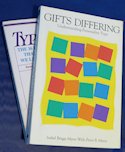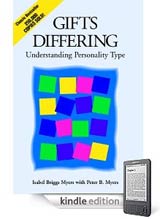
- About the MBTI
- Verify Your MBTI Type
- Personality Patterns
- MBTI Articles & Resources
- Article Directory for Educators & Students
- Books on Personality Types
- Emotional Intelligence & Personality Type
- Career Planning & MBTI
- MBTI Business Applications
- Lenore Thomson - Carl Jung Personality Type
- Site Map - Master Directory of All Articles
- MBTI Consultant Links
- Personality Type Workshops & Conferences
- Links to Other Type Websites
- Murder Mystery Business Theatre
- About Us
Volume 1, No. 2
Page 1. Am I an unconventional Type?
Page 2. Mental Functions vs Skills
Page 3. Jung's Individuation
Am I an unconventional Personality Type?
Are Jung's mental functions like abilities or skills?
What did Jung mean by "individuation?"
Lenore Thomson Bentz . . . on Personality Type - Volume 1, No. 2.
Have a question about Personality Type or Carl Jung's Theory of Psychological Type? Send them to Lenore at lthombentz@aol.com. She will respond in this ongoing "Dear Lenore" column.
![]()
Questions Addressed in this issue:
Am I an unconventional Type? [this page]
Are Jung's mental functions like abilities or skills?
What did Jung mean by "individuation?"
Question: When I discovered my ISFP preferences several years ago, I felt validated, even though I had problems answering the J/P questions. Now that I've taken the type test in your book, I had an even harder time deciding between the options. I don't like to be scheduled and controlled, but I do find that I order up structure all the time to find enough freedom to create.
For example, when I was studying roses, there are so many out there, I first limited the field to old garden roses -- those before the late 1800's when Hybrid Tea's began to be developed. That wasn't nearly enough structure so I eventually limited these to fragrant, climbing garden roses, with an emphasis on species types.
And when confronted with a blank piece of paper for painting, I need structure so much that I chose to study botanical illustration. "Light over the left shoulder at 11:00, object centered on the page... etc."
This just doesn't sound like the conventional description of SP types. Is my dominant Fi working overtime? -- Dorothy G., from Dallas, Texas
Lenore Answers: The enduring value of the J-P category is that it allows one to determine, by attitude, which function is dominant in a type.
Extraverted J type = Te or Fe dominant
Extraverted P type = Se or Ne dominant
For Introverted types, it's the other way around.
Introverted J type = Ni or Si dominant
Introverted P type = Ti or Fi dominant
Convenient as this model is for purposes of type interpretation (and I obviously depend on it in my own type instrument), it can be misleading when J and P are treated as abstractions that have meaning in and of themselves. For one thing, the questions posed in this category refer only to a type's Extraverted attitudinal preference.
That is, they refer to collective forms of structure -- sources of authority imposed from the outside. They ask about deadlines and rules, the desire to anticipate and manage one's experience. And these are pitted against flexibility and freedom, the ability to adapt and respond to immediate change.
These options are clearly valid ones. J types, in general, want to know what to expect from the outer world, and P types are guided more by circumstances as they occur. However, when J and P are treated as abstractions, the model implies that structure is only a matter of external constraint, and that freedom always means the rejection of outward convention. There are no questions that refer to deliberately cultivated internal structure, or to self-imposed limitations that keep one from being paralyzed by too many external options.
As a result, J types are usually stereotyped as executive sorts, the strict constructionists among us, attempting to control their outer environment with guidelines for behavior, and P types are stereotyped as spontaneous, inventive, aspirational, and resistant to authority. Moreover, J types wind up credited with many of the characteristics that Jungians traditionally associate with Sensation -- particularly, an adaptive response to temporal and spatial limitation. This is part of what distinguishes a Sensate from an iNtuitive, who attempts to see around the corners of apparent limitation, even when it's impractical to do so.
My own belief is that all Perceiving functions (Ne, Ni, Se, and Si) operate by way of cross-referencing information that reaches us at different times and in different places. This is an intrapsychic process, and it's different from the discrimination that we associate with Judgment.
Even the lowest organisms have some capacity to delay their response to potential food or predators until sufficient elements of the situation have been registered and compared to others. This is what ensures a successful choice between "eat or be eaten or "good or bad."
Perception appears to be the cognitive derivative of that capacity. It creates a kind of "delay space," an interpretive domain, wherein information that arrives from different sources at different times can be related, coordinated, and assembled into a meaningful whole.
A Perceiving function, therefore, encourages one to keep that "delay space" open, putting off Judgment's definition of the field as complete and warranting decisive interpretation and action.
Just as an aside, this is one reason I don't see Sensation as concerned with the past and iNtuition with the future. The receipt of information that Perception represents is necessarily atemporal, or cross-referencing would not be possible.
Jung's own example of iNtuition was a woman who just "knew," without understanding how she knew, that the patient in the hour before hers smoked cigars. Jung was fascinated by that. A Sensate, he said, could have easily looked at the butts in the ashtray and smelled the smoke and drawn the same conclusion. But the woman had done all her processing unconsciously, so she was unaware of the cues she'd picked up in order to come up with the pattern she inferred.
There is nothing in this example that even suggests past and future. The whole emphasis is on conscious and unconscious processing. Yes, iNtuitives may infer implications before all the facts are in, but this, too, indicates cross-referencing -- comparing what one sees in the present situation to patterns already stored and capable of unconscious revision.
What I "hear" in your own creative strategy is a specifically Sensate way of limiting the field in which your information is being stabilized and cross-referenced. It's neither J nor P in the classic sense of those terms. Rather, the enterprise narrows your focus in a practical way, making use of temporal and spatial limitation to establish a manageable field of information. This frees you to change your tactics as your materials change, without directing your project to a preordained end point. Your Fi dominant, meanwhile, is determining value and direction, telling you when your project is complete.
In summary, I don't believe that your Fi is "working overtime." Rather, I believe that Se is doing its job as your primary means of Perception.
~ ~ ~ ~ ~
 Next Page - Jung's mental functions equals skills or ability?
Next Page - Jung's mental functions equals skills or ability?
Lenore Thomson is author of "Personality Type: An Owner’s Manual" and the former editor of the Jungian Journal Quadrant and a lecturer with the C.G. Jung Foundation in New York City. |
® MBTI, Myers-Briggs, Meyers Briggs, and Myers-Briggs Type Indicator are registered trademarks or trademarks of the Myers-Briggs Type Indicator Trust in the United States and other countries (aka meyers briggs or myers briggs).
![]()
Go Here to Learn more about Type Dynamics: The Dynamics of Type: Interpreting the MBTI ®Personality Type Code.
Go Here to Learn more about The Myers-Briggs Test *
*While commonly called a "test" the MBTI ® is not a test but a personality inventory in which there are no right or wrong answers.

"Personality Type: An Owner's Manual" by Lenore Thomson
A layman's guide to understanding Personality Type and the theory of Psychological Types originally proposed by C. G. Jung. Lenore Thomson was the former editor of the Jungian Journal Quadrant and a lecturer with the C.G. Jung Foundation in New York City.
[Ordering Info Here]
Gifts Differing: Understanding Personality Type
- Kindle eBook -
Go Here for
Kindle eBooks on Personality Type
© Published by Ross Reinhold & Reinhold Development 1997 - 2023
Privacy Policy About Us


